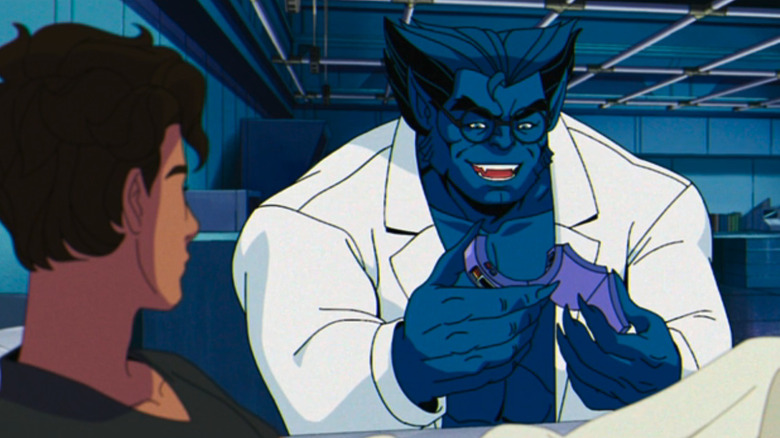Why Is Time Traveling Bishop Still Hanging Around In X-Men '97?
The character of Bishop first appeared in "The Uncanny X-Men" #282 in November 1991. When he gets blasted by a laser beam or radioactive ray, Bishop can absorb the energy into his body and redirect it back at his attacker. He has been a reliable supporting player in X-Men comics ever since 1991. He has also appeared in "X-Men: The Animated Series," and was played by Omar Sy in 2014's "X-Men: Days of Future Past."
Bishop is also, notably, a time traveler. In the lore of "X-Men: The Animated Series," he came to the present (1993) from a dystopian 2055 that had been overrun by mutant-killing Sentinels. Bishop (played by Philip Aiken) aimed to assassinate one of the X-Men, believing that their death will undo the grim future. Luckily, the misunderstanding was cleared up, and a different assassination was prevented. Bishop returned to 2055 after assuming he had repaired the timeline... but nothing had changed. There is a grim sense of fatalism to Bishop's sad life.
Bishop returned in the show's second season to prevent a virus from breaking out, and in the third season, he went back in time to 1959 to help out a younger version of Professor X. All told, Bishop only appeared in 10 episodes of the series, but he was able to leap around in time using a wrist-mounted time-travel widget.
In the 2024 revival of "X-Men: The Animated Series," called "X-Men '97," Bishop (now voiced by Isaac Robinson-Smith) is back in the present, now fighting alongside the X-Men as a regular member of the team. Why is he there? Why doesn't he return to his own time?
Well, apart from the fact that Bishop is a badass that X-Fans likely want to see more of, the explanation is simple: his time-travel widget broke.
Beast can't fix everything
In the first three episodes of "X-Men '97," airing on Disney+ on March 20 and March 27, it will be explained that Bishop traveled back in time to 1997 and had to stay there when his ability to return was taken from him. For Bishop, this may have been a positive move, as he seems perfectly at home in the past, fighting alongside other mutants that he easily gets along with.
It's not explained, however, why he came back to 1997 this time. Perhaps it was just to visit. The X-Men don't always have to have missions, after all. Perhaps Bishop was in the year 1997 for social reasons. He had heard about this awesome ancient movie called "Face/Off," and he wanted to watch it with Jubilee.
Regardless, this last trip was rough on Bishop's time-travel bracelet, as it typically was. Time travel is possible in the X-Men universe, but it's not always the easiest endeavor, and Bishop found himself staggering through portals and stranded in various timelines for certain spells. In "X-Men '97," it is said that Bishop will not be able to return to 2055 until the brilliant Dr. Hank McCoy, aka Beast, can repair it. It's only mentioned in passing, but it's enough to allow Bishop to stay on the show.
Also, when it comes to adapting superhero teams to film or television, there is a secondary fatalistic notion at play. The X-Men have to be presented with a certain lineup merely because that's the way they previously appeared on the page. "X-Men: The Animated Series" is extrapolated from 1990s X-Men comics, and Bishop was in that mix. Is Bishop cool? Is he a '90s character? Yes to both. That's plenty of reason to let him stick around.

